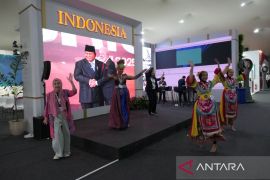The main objective behind the inking of the MoU was to reduce plant emissions and air pollution.
Director of Corporate Planning & Business Development at PLN Hartarto Wibowo remarked that the collaboration between PLN Enjiniring, a subsidiary of PLN and IRT, as the developer of the Jawa 9&10 PLTU, is aimed at the possibility of using green ammonia as primary fuel for PLTU to reach as much as 60 percent, as Jawa 9&10 had already been equipped with SCR technology.
“We hope that the study will produce something extraordinary. This will be our way to make the coal power plant even more environmentally friendly," he stated.
The signing of this agreement was conducted in between the B20 series in Nusa Dua Bali on Monday (Nov 14).
The Selective Catalytic Reduction (SCR) technology and the use of green ammonia as primary energy are one of the options currently being developed to reduce carbon emissions in Steam Power Plants (PLTU).
This technology, which has the potential to be used in several PLTUs, is part of the efforts to decarbonize the effects of burning coal.
According to Wibowo, the feasibility study can be completed within the next three months. Thereafter, the results can be presented to the Directorate General of New Renewable Energy and Energy Conservation (EBTKE), the Ministry of Energy and Mineral Resources (ESDM).
"This all is for a more renewable life," he affirmed.
On the same occasion, Director General of EBTKE Dadan Kusdiana said, so far, strong efforts had been made by both the government and PLN in decarbonizing PLTU. The steps taken by the management of coal fire-power plant PLTU Jawa 9&10 with SCR technology that uses "green ammonia" is an option that is being studied comprehensively. He is optimistic that this study would not take long.
“There is nothing wrong with coal because it is useful as a product. What we avoid is that coal ends up in C02. That is why we have to find ways to reduce or absorb the emissions," he emphasized.
The most practical way might be to replace the coal-fired power plant.
"However, there are assets and all economic values. That is why we consider the way of decarbonization. If this (MoU) leads to hydrogen and ammonia, I think this is a smart path," he remarked.
Dadan emphasized that currently, the government was actively encouraging various efforts and studies to implement a zero carbon emission policy or Net Zero Emissions (NZE).
"We are pursuing all alternatives. The direction is how we reduce CO2. In the end, no CO2 comes out," Dadan remarked.
President Director of PT Indo Raya Tenaga Peter Wijaya said that IRT and Jawa 9&10 will be ready for significant green ammonia co-firing if and when PLN directives on alternative fuel sources become available in future.
"Our target is we are ready, so if PLN is looking to transition from coal energy to green ammonia, then this PLTU is ready," he stated.
"Why do we want to use SCR because we want to be different from the others. So, there is only one PLTU that uses Ultra Super-Critical USC and SCR technology, namely PLTU Jawa 9 and 10," he said.
PLTU Jawa 9&10 is one of the ultra-super critical plants in Indonesia, as it installs the most complete emission control equipment to reduce air pollution with Flue Gas Desulfurization, Electro-Static Precipitator, Low NOx burner and Selective Catalytic Reduction (SCR).
The use of CSR in the PLTU in conjunction with a Low NOx burner will significantly reduce the levels of nitrogen oxides and nitrogen dioxide, thereby opening up the possibility of burning more green ammonia than coal in PLTU.
With this joint study, PLTU Jawa 9&10 in Banten will be ready for significant green ammonia co-firing whenever PLN directives on alternative fuel sources become available in future.
Related news: Indonesia's biggest thermal power plant is operational
Related news: PGE to increase GPP capacity in South Sumatra for NZE
Translator: Satyagraha, Azis Kurmala
Editor: Rahmad Nasution
Copyright © ANTARA 2022












